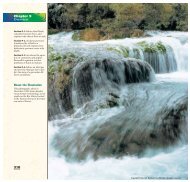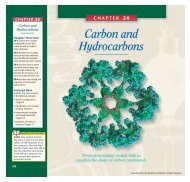Physical Characteristics of Gases
Physical Characteristics of Gases
Physical Characteristics of Gases
You also want an ePaper? Increase the reach of your titles
YUMPU automatically turns print PDFs into web optimized ePapers that Google loves.
flow causes gases to behave similarly to liquids. Because liquids and<br />
gases flow, they are both referred to as fluids.<br />
Low Density<br />
The density <strong>of</strong> a substance in the gaseous state is about 1/1000 the density<br />
<strong>of</strong> the same substance in the liquid or solid state.That is because the<br />
particles are so much farther apart in the gaseous state (assumption 1).<br />
Compressibility<br />
During compression, the gas particles, which are initially very far apart<br />
(assumption 1), are crowded closer together. The volume <strong>of</strong> a given<br />
sample <strong>of</strong> a gas can be greatly decreased. Steel cylinders containing<br />
gases under pressure are widely used in industry. When they are full,<br />
such cylinders may contain 100 times as many particles <strong>of</strong> gas as would<br />
be contained in nonpressurized containers <strong>of</strong> the same size.<br />
Diffusion and Effusion<br />
<strong>Gases</strong> spread out and mix with one another, even without being stirred.<br />
If the stopper is removed from a container <strong>of</strong> ammonia in a room,<br />
ammonia gas will mix uniformly with the air and spread throughout the<br />
room. The random and continuous motion <strong>of</strong> the ammonia molecules<br />
(assumption 3) carries them throughout the available space. Such spontaneous<br />
mixing <strong>of</strong> the particles <strong>of</strong> two substances caused by their random<br />
motion is called diffusion.<br />
The rate <strong>of</strong> diffusion <strong>of</strong> one gas through another depends on three<br />
properties <strong>of</strong> the gas particles: their speeds, their diameters, and the<br />
attractive forces between them. In Figure 10-2, hydrogen gas diffuses<br />
rapidly into other gases at the same temperature because its molecules<br />
are lighter and move faster than the molecules <strong>of</strong> the other gases.<br />
H 2<br />
Stopcock<br />
closed<br />
(a) (b)<br />
O 2<br />
FIGURE 10-2 When hydrogen gas in a flask is allowed to mix with air at<br />
the same pressure in another flask, the low-mass molecules <strong>of</strong> hydrogen diffuse<br />
rapidly into the flask with the air. The heavier molecules <strong>of</strong> nitrogen and<br />
oxygen in the air diffuse more slowly into the flask with the hydrogen.<br />
Copyright © by Holt, Rinehart and Winston. All rights reserved.<br />
N 2<br />
NSTA<br />
TOPIC: Diffusion/effusion<br />
GO TO: www.scilinks.org<br />
sci LINKS CODE: HC2102<br />
Stopcock<br />
open<br />
PHYSICAL CHARACTERISTICS OF GASES 305<br />
SECTION 10-1<br />
Diffusion and effusion as they relate<br />
to Graham’s law are covered again in<br />
Chapter 11.<br />
305

















